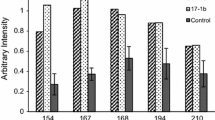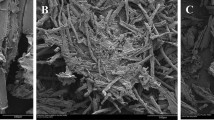Abstract
Downregulated lignin transgenic black cottonwood (Populus trichocarpa) was used to elucidate the effect of lignin and xylan content on enzymatic saccharification. The lignin contents of three transgenic samples (4CL1-1, 4CL1-4, and CH8-1-4) were 19.3, 16.7, and 15.0 %, respectively, as compared with the wild type (21.3 %). The four pretreatments were dilute acid (0.1 % sulfuric acid, 185 °C, 30 min), green liquor (6 % total titratable alkali, 25 % sulfidity based on TTA, 185 °C, and 15 min.), autohydrolysis (185 °C, 30 min), and ozone delignification (25 °C, 30 min). Following the pretreatment, enzymatic saccharification was carried out using an enzyme charge of 5 FPU/g of substrates. The removal of lignin and hemicellulose varies with both the types of pretreatments and the lignin content of the transgenic trees. Due to the greatest removal of lignin, green liquor induced the highest sugar production and saccharification efficiency, followed by acid, ozone, and autohydrolysis in descending order. The results indicated that lignin is the main recalcitrance of biomass degradation. At a given lignin content, pretreatment with ozone delignification had lower saccharification efficiency than the other pretreatment methods due to higher xylan content.




Similar content being viewed by others
References
Wang, M., Wu, M., & Huo, H. (2007). Life-cycle energy and greenhouse gas emission impacts of different corn ethanol plant types. Environmental Research Letters, 2, 1–13.
Licht, F. O. (2006). World ethanol markets: the outlook to 2015; Agra Europe special report: Tunbridge Wells.
Taherzadeh, M. J., & Karimi, K. (2007). Acid-based hydrolysis processes for ethanol from lignocellulosic materials: a review. BioResources, 2, 472–499.
Taherzadeh, M. J., & Karimi, K. (2007). Enzymatic-based hydrolysis processes for ethanol from lignocellulosic materials: a review. BioResources, 2, 707–738.
Wyman, C. E. (1996). Handbook on bioethanol: production and utilization. Washington DC: Taylor & Francis.
Berlin, A., Balakshin, M., Gilkes, N., Kadla, J., Maximenko, V., Kubo, S., et al. (2006). Inhibition of cellulase, xylanase and beta-glucosidase activities by softwood lignin preparations. Journal of Biotechnology, 125, 198–209.
Karimi, K., Kheradmandinia, S., & Taherzadeh, M. J. (2006). Conversion of rice straw to sugars by dilute acid hydrolysis. Biomass and Bioenergy, 30, 247–253.
Sanchez, G., Pilcher, L., Roslander, C., Modig, T., Galbe, M., & Liden, G. (2004). Dilute-acid hydrolysis for fermentation of the Bolivian straw material Paja Brava. Bioresource Technology, 93, 249–256.
Alizadeh, H., Teymouri, F., Gilbert, T. I., & Dale, B. E. (2005). Pretreatment of switchgrass by ammonia fiber explosion (AFEX). Applied Biochemistry and Biotechnology, 124, 1133–1141.
Sassner, P., Galbe, M., & Zacchi, G. (2005). Steam pretreatment of Salix with and without SO2 impregnation for production of bioethanol. Applied Biochemistry and Biotechnology, 121, 1101–1117.
Jin, Y., Jameel, H., Chang, H. M., & Phillips, R. B. (2010). Green liquor pretreatment of mixed hardwood for ethanol production in a repurposed Kraft Pulp Mill. Journal of Wood Chemistry and Technology, 30(1), 86–104.
Wu, S., Chang, H.-m., Jameel, H., & Phillips, R. B. (2010). Novel green liquor pretreatment of loblolly pine chips to facilitate enzymatic hydrolysis into fermentable sugars for ethanol production. Journal of Wood Chemistry and Technology, 30(3), 205–218.
Chen, C. L. (1992). Nitrobenzene and cupric oxide oxidations. In S. Y. Lin & C. W. Dence (Eds.), Methods in lignin chemistry (pp. 301–321). Berlin: Springer.
Pan, G. Y., Chen, C. L., Chang, H. M., & Gratzl, J. S. (1984). Studies on ozone bleaching I., the effect of pH, temperature, buffer system and heavy metal-ions on stability of ozone in aqueous solution. Journal of Wood Chemistry and Technology, 4(3), 367–387.
Kabel, M. A., Bos, G., Zeevalking, J., Voragen, A. G. J., & Schols, H. A. (2009). Effect of pretreatment severity on xylan solubility and enzymatic breakdown of the remaining cellulose from wheat straw. Bioresource Technology, 8, 2034–2042.
Parveen, K., Barrett, D. M., Delwiche, M. J., & Stroeve, P. (2009). Methods for pretreatment of lignocellulosic biomass for efficient hydrolysis and biofuel production. Industrial and Engineering Chemistry Research, 48, 3713–3729.
Mohammad, J. T., & Keikhosro, K. (2008). Pretreatment of lignocellulosic wastes to improve ethanol and biogas production: a review. International Journal of Molecular Sciences, 9, 1621–1651.
Thompson, D. N., Chen, H. C., & Grethlein, H. E. (1992). Comparison of pretreatment methods on the basis of available surface area. Bioresource Technology, 39, 155–163.
Brunecky, R., Vinzant, T. B., Porter, S., Donohoe, B. S., Johnson, D. K., & Himmel, M. (2009). Redistribution of xylan in maize cell walls during dilute acid pretreatment. Biotechnology and Bioengineering, 102(6), 1537–1543.
Ashok, P. (Ed.). (2009). Handbook of plant-based biofuels. Boca Raton: CRC Press. ISBN 1560221755, 9781560221753.
Parveen, K., et al. (2009). Methods for pretreatment of lignocellulosic biomass for efficient hydrolysis and biofuel production. Industrial and Engineering Chemistry Research, 48, 3713–3729.
Thompson, D. N., et al. (1992). Comparison of pretreatment methods on the basis of available surface area. Bioresource Technology, 39, 155–163.
Sun, Y., & Cheng, J. (2002). Hydrolysis of lignocellulosic materials for ethanol production: a review. Bioresource Technology, 83, 1–11.
Pipon, G., et al. (2007). Comparative effect of ozone, chlorine dioxide, and hydrogen peroxide on lignin: reactions affecting pulp color in the field bleaching stage. Holzforschung, 61, 628–633.
Gharpuray, M. M., et al. (1983). Structural modification of lignocellulosics by pretreatments to enhance enzymatic hydrolysis. Biotechnology and Bioengineering, 25, 157–172.
Acknowledgments
The authors are grateful to the Southeastern Sun Grant Center of the USA for the financial support of this study and to Novezymes North America, Inc., for providing the enzymes used in this study.
Author information
Authors and Affiliations
Corresponding author
Rights and permissions
About this article
Cite this article
Min, D., Li, Q., Jameel, H. et al. The Cellulase-Mediated Saccharification on Wood Derived from Transgenic Low-Lignin Lines of Black Cottonwood (Populus trichocarpa). Appl Biochem Biotechnol 168, 947–955 (2012). https://doi.org/10.1007/s12010-012-9833-2
Received:
Accepted:
Published:
Issue Date:
DOI: https://doi.org/10.1007/s12010-012-9833-2




